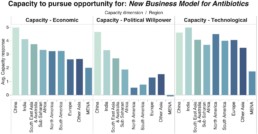New arrangement of collaboration including open source solutions are promising avenues for restarting the quest for new antibiotics.
Developing new drugs is costly. A billion-dollar price tag is not uncommon – and often too small – but considering the cost of antimicrobial resistance (AMR), this is actually a bargain. In the United States alone AMR costs more than 50 billion USD per year in health expenses and incurred societal cost – such as loss of productivity.
Still, development of new antibiotics has stifled, as current pharmaceutical business models do not harvest this opportunity. Development costs of new antibiotics are high, yet sales are impended as consumers only take antibiotics for a limited time period and often relatively few times during a lifetime. At the same time, microbes develop resistance relatively fast. So to be profitable, antibiotics today need to be sold in large quantities, but if sold in profitable quantities the risk of microbes developing resistance goes up dramatically. This catch-22 situation has kept the development of new antibiotics drugs down.
However, the enormous societal costs of AMR create an opportunity for new business models to step in, and a number are materializing.

Public-Private Funding
The term neglected disease business models covers a number of tools to incentivize investments in development of new drugs to treat diseases where traditional business models do not create favorable returns on investments. Using these similar measures can help bring novel antibiotics to the market. The incentives are a mix of innovative approaches to R&D, new forms of financing mechanisms and regulatory tools.
A key element in this opportunity is to blend public and private investment in innovative financing models that can fund the development of new drugs. Funds for research on this topic can be partly financed by the public sector, philanthropy, or one could imagine for instance a one-billion-dollar prize to the first five companies or academic centers that develop and get regulatory approval for a new class of antibiotics. Rewards could also be in the form of higher drug prices protected by patents or extended data exclusivity. Financial incentives can be targeted to the truly novel classes of antibiotics, with demonstrable efficiency against multidrug-resistant pathogens.
Innovative Approaches to R&D
Another way to incentivize development of new antibiotics is to reduce the cost of development. Open source innovation plays a key role as a means to create avenues for companies to benefit from publicly funded research. Sourcing ideas on open platforms have proven effective in the development of drugs for neglected diseases such as tuberculosis, and this type of networked approach to R&D has demonstrated that while its costs and challenges may be too great for just one company to bear, platforms that draw on a multitude of collaborators may lower costs, diffuse risks, and recruit a broad array of resources.
New forms of public-private collaboration and open source solution hunting are potentially promising ways to revamp the interest in developing more of our miracle medicine – antibiotics.
Survey Findings
A new business model for antibiotics has been assessed very differently across the regions in terms of potential benefits for society and the capacity to pursue it. Very few business models currently exist to address this problem that may render it difficult for respondents to judge the value of the opportunity.

Respondents in China have assessed this market opportunity very positively which points to the fact that there is a felt need in the region for the development of new business models for antibiotics. China is among one of the largest users of antibiotics worldwide. India, the MENA region, and South America have also rated this opportunity favorably. However, the opportunity is less favorable in the eyes of Europe, South East Asia and Australia, and Other Asia.
Respondents in the manufacturing sector are especially optimistic with respect to the market’s positive impacts on society; still, it is not a market opportunity the sector sees much new business potential in. The service sector is the most likely to pursue this opportunity, however, the sector does not have high hopes in terms of the benefits this opportunity will bring society.

Besides strong support from stakeholders in China and India, a new business model for antibiotics the data shows that the opportunity will be backed up by stakeholders in Sub Saharan Africa and South East Asia and Australia and by civil society in South America.
This market was surveyed globally in 2015 by more than 5500 leaders from both the public and private sectors. The survey was conducted in collaboration with the research company YouGov. The survey results were originally published in the Global Opportunity Report 2016.

